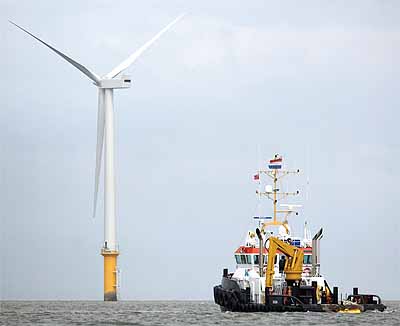Siemens Wind Power
Siemens blows the competition away
Siemens Wind Power offers innovative solutions that use highly efficient and reliable wind turbines to harness natural wind energy to provide a sustainable source of renewable power.
Previously operating as Bonus Energy, Siemens Wind Power is a division of Siemens Power Generation, a prominent company in the international power generation sector providing cutting-edge energy solutions.
“Bonus Energy began in 1980 with three people and £20,000, and grew organically to accrue more than 850 employees and a £200 million annual turnover by 2004,” says Henrik Stiesdal, chief technology officer. “We are the world’s oldest existing wind turbine manufacturer and have always been a conservatively solid business. As part of a generation change, the company was acquired by Siemens in 2004. Since then, Siemens has grown the business very successfully – the number of employees has increased by a factor of four and the turnover has grown by a factor of five. Our core business has always been technically demanding onshore and offshore projects for utilities and utility associations operating in power generation – basically the major players in the power industry in Europe and the US. Today we are one of the leading wind turbine manufacturers in the world, and we are now expanding to become a truly global player.”
Since entering the wind industry, Siemens has greatly extended the capacity of its manufacturing network by expanding its Danish facilities in Brande and Aalborg, and opening a new blade factory in Engesvang, DK. Most recently it opened a £14 million blade factory in Iowa, the US, which is expected to produce approximately 600 wind turbine blades annually to serve the North American market. Henrik says: “Practically all manufacturing takes place in Denmark where our headquarters are based although our Iowa site, which had its formal inauguration in September 2007, will meet a significant proportion of the need for blades in the US.”
R&D is an integral aspect of the company’s operation, particularly since the innovation driven Siemens took control. “We focus very firmly on innovation in our turbines and this has certainly increased since the acquisition,” reveals Henrik. “With the turbine blades, for example, we have developed a process that allows us to cast blades in a one-step closed process, which provides a strong structure because it doesn’t have glue joints. Due to the closed process workers aren’t exposed to anything harmful.”
Siemens is currently working in partnership with Norsk Hydro, an international supplier of energy and aluminium, to develop the world’s first floating wind turbines that will be more effective than fixed foundation and gravity concepts. “The industry has traditionally used two different technologies to install foundations in the sea floor,” explains Henrik. “One is a concrete gravity base, essentially a large flat plate on the sea floor featuring a central pedestal that emerges from the sea with a turbine on top, and the other is a hollow steel pipe hammered into the sea floor with a turbine sitting on top of that. These solutions work at water depths up to about 30 metres. The beauty of the Norsk Hydro idea is that the turbine doesn’t have to be firmly embedded in the sea floor which is a big advantage because, unlike Denmark, many countries have very deep water or shallow areas that are unsuitable for offshore wind farms. With Norsk Hydro, we can place turbines at any water depth to hugely increase available sea areas. It is a very simple idea and reduces costs significantly as it’s just a floating upright cylinder with a big counter weight at the lower end and three anchor lines. It’s an excellent partnership because we’re very competent with wind and Norsk Hydro has experience with deepwater offshore operations through its work in the oil and gas industry using hefty equipment in deepwater and rough conditions.”
Henrik believes such strategic alliances and decisions have helped the company to progress profitably and efficiently: “In the complex and turbulent world of wind, we prioritise quality, the effectiveness of our machines, our consistently conservative business approach and our ability to solve any problems quickly in order to succeed. The design works cover aspects from fibreglass and steel to computer software and electronics so our technicians have interesting work, and we’re at the cutting edge of technology – our blade is the biggest produced fibreglass object anywhere in the world.”
With regards to succeeding in the future, Henrik feels his division is well positioned as opportunities continue to materialise: “We see huge potential for growth in the wind industry, irrespective of our offshore development with Norsk Hyrdo, due to the realisation that wind energy is increasingly appealing. The floating foundation is a long-term strategic project and simply by having this cooperation we have expansion potential and security in the future market. At the moment, the boom in the wind industry is so big that the challenge lies in producing components fast enough but even when the boom reduces we’ll strive to grow whilst retaining that quality and solid business approach that has allowed us to function so well. I’m confident we can manage this and our ultimate goal is to credibly compete with conventional energy sources,” he concludes.
Siemens Wind Power
Products: Wind turbines
Sites: Denmark and the US
Employees: 2300
www.siemens.com/powergeneration
